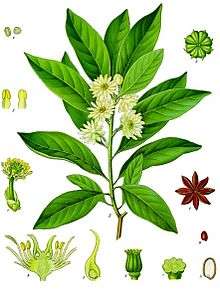Illicium anisatum
Illicium anisatum, with common names Japanese star anise,[1] Aniseed tree,[1] and sacred Anise tree,[1] known in Japan as shikimi (樒, シキミ), is a tree closely related to the Chinese star anise (Illicium verum). Since it is highly toxic, the fruit is not edible; instead, the dried and powdered leaves are burned as incense in Japan. Its branches and evergreen leaves are considered highly sacred by Japanese Buddhists[2] due to their ability to remain fresh after pruning.
| Japanese star anise | |
|---|---|
 | |
| Japanese star anise | |
| Scientific classification | |
| Kingdom: | Plantae |
| Clade: | Tracheophytes |
| Clade: | Angiosperms |
| Order: | Austrobaileyales |
| Family: | Schisandraceae |
| Genus: | Illicium |
| Species: | I. anisatum |
| Binomial name | |
| Illicium anisatum | |
| Synonyms | |
Illicium anisatum is native to Japan. It is similar to the Chinese star anise, but its fruit is smaller and with a weaker odour, reputed to be similar to cardamom than anise. Due to its poisonous nature, its seeds have been used as a fish poison as well as a natural agricultural pesticide to repel animals from digging the grounds of Japanese graveyards.[3] Its seeds have also been used medicinally to treat toothache and dermatitis topically, since it is unsuitable for internal use.[3]
Toxicity and accidental use in food products
Japanese star anise contains anisatin, shikimin, and sikimitoxin, which cause severe inflammation of the kidneys, urinary tract, and digestive organs.[4] Other compounds present in toxic species of Illicium are safrole and eugenol, which are not present in the edible Chinese star anise and are used to identify its toxicity. Shikimic acid, a substance also present in Japanese star anise, is so-called after the plant's Japanese name.
In Europe, Chinese star anise tea is often used as a stress-relief tea.[5] Cases of illness have been reported in France, Spain, and Switzerland after people were reported consuming contaminated Chinese star anise tea with Japanese star anise.[5] This contamination hospitalized many people with epilepsy, hallucinations, and nausea all as a result of the toxin anisatin, found in the Japanese star anise.[5] In 2001, there was a large outbreak of toxicity in the Netherlands due to accidental contamination of a tea blend containing more than 6 different tea plants with the Japanese star anise.[5]
Due to its morphological similarities, it is impossible to distinguish Chinese and Japanese star anise in its dried or processed form by its appearance only, and can only be unequivocally determined by using botanical microscopy.[5] This process must be done before the plants have been made into tea and dried out.[5]
Cases of product recalls have been reported when products containing star anise were found to be contaminated by Japanese anise.[6] Cases of consumers admitted to hospital with neurological symptoms after ingesting excessive doses of star anise or smaller doses of products contaminated with Japanese anise have also occurred.[6]
Essential oil components
The essential oil of air-dried I. anisatum seeds obtained by hydrodistillation was analysed by GC–MS. Fifty-two components were identified in the essential oil, the main component being eucalyptol (21.8%).[7]
In literature
The sixteenth-century Chinese anthology Strange Stories from a Chinese Studio includes a story titled "The Shuimang Herb" whose titular plant is inspired by Illicium anisatum.[8]
Gallery
.jpg) Flower
Flower.jpg) Mature leaves of the shikimi plant, bearing its flowers
Mature leaves of the shikimi plant, bearing its flowers An artificial shikimi plant distributed by Soka Gakkai for their altars
An artificial shikimi plant distributed by Soka Gakkai for their altars
See also
| Wikimedia Commons has media related to Illicium anisatum. |
References
- "Taxonomy - GRIN-Global Web v 1.10.2.8". npgsweb.ars-grin.gov. Retrieved 2018-04-27.
- Simpson, Michael (2010). Plant Systematics. Elsevier. pp. 189. ISBN 978-0-12-374380-0.
- Small, Ernest (1996). "Confusion of Common Names for Toxic and Edible "Star Anise" (Illicium) Species". Economic Botany. 50 (3): 337–339. JSTOR 4255854.
- V. A. Parthasarathy, Bhageerathy Chempakam, T. John Zachariah (2008). Chemistry of Spices. CABI. p. 320.CS1 maint: multiple names: authors list (link)
- Shen, Yao; van Beek, Teris A.; Claassen, Frank W.; Zuilhof, Han; Chen, Bo; Nielen, Michel W.F. (2012). "Rapid control of Chinese star anise fruits and teas for neurotoxic anisatin by Direct Analysis in Real Time high resolution mass spectrometry". Journal of Chromatography A. 1259: 179–186. doi:10.1016/j.chroma.2012.03.058. ISSN 0021-9673. PMID 22484123.
- FDA Issues Advisory on “Teas”: Teas Made from Star Anise Were Associated With Illnesses Including Seizures, US Food and Drug Administration.
- JI-YOUNG KIM et all, Chemical composition, antioxidant, anti-elastase, and anti-inflammatory activities of Illicium anisatum essential oil, Acta Pharm. 59 (2009) 289-300.
- Pu, Songling; Sondergard, Sidney L. (2008). Strange Tales from Liaozhai. 1. Jain Publishing Company. p. 248. ISBN 9780895810458.